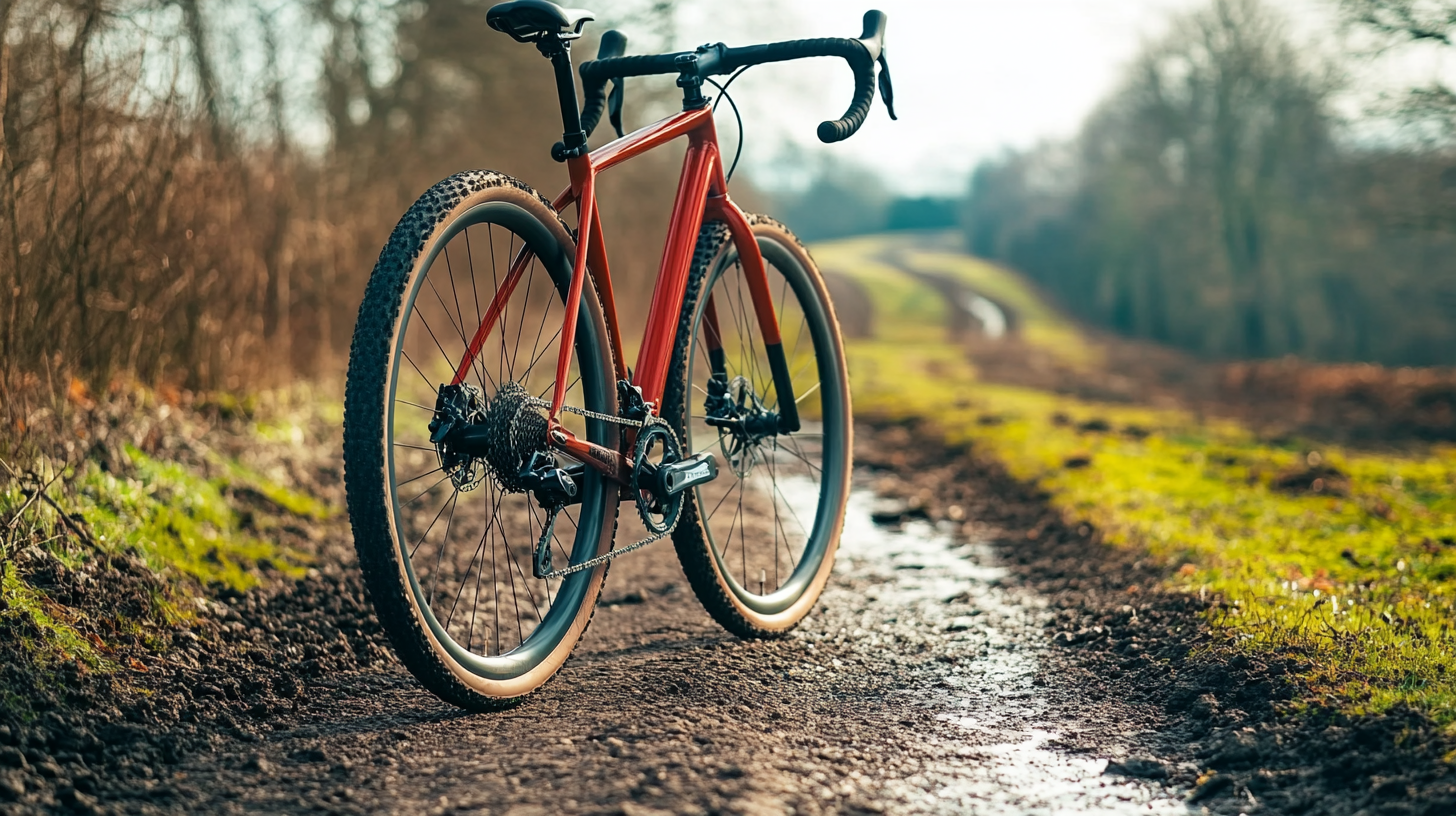 Choosing the right Carbon Gravel Fork is crucial for enhancing your gravel bike's performance and ensuring a comfortable, smooth ride on varied terrains. With a myriad of options available in the market, selecting the perfect fork can be overwhelming for both novice and experienced riders alike. This blog will guide you through five essential tips that will simplify your decision-making process, helping you to identify the features that best meet your cycling needs. Whether you prioritize weight, compliance, or compatibility with your bike's geometry, our comprehensive insights will empower you to make an informed choice. Get ready to unlock the true potential of your gravel bike with the ideal Carbon Gravel Fork tailored specifically for your adventures.
Choosing the right Carbon Gravel Fork is crucial for enhancing your gravel bike's performance and ensuring a comfortable, smooth ride on varied terrains. With a myriad of options available in the market, selecting the perfect fork can be overwhelming for both novice and experienced riders alike. This blog will guide you through five essential tips that will simplify your decision-making process, helping you to identify the features that best meet your cycling needs. Whether you prioritize weight, compliance, or compatibility with your bike's geometry, our comprehensive insights will empower you to make an informed choice. Get ready to unlock the true potential of your gravel bike with the ideal Carbon Gravel Fork tailored specifically for your adventures.
When selecting the ideal carbon gravel fork, understanding your riding style and terrain preferences is crucial for making the best choice. Different riding styles, such as endurance, racing, or casual riding, demand specific qualities from a fork. For instance, if you frequently tackle long rides on rough terrain, prioritizing a fork that is designed for stability and shock absorption will enhance your comfort and performance. Look for features like wider clearance for larger tires, which can help you conquer a variety of surfaces without sacrificing ride quality.
Another important aspect is recognizing the type of terrain you usually encounter. If your rides include steep climbs or mixed surfaces, a lightweight fork that maintains strength can significantly impact your overall riding experience. A tip to consider is checking the fork's geometry to ensure compatibility with your bike frame and riding dynamics. This will not only improve handling but also provide confidence while navigating technical sections. Additionally, carefully consider the level of vibration dampening offered by the fork, as this can make a world of difference on bumpy gravel roads.
When selecting the best carbon gravel fork, evaluating weight, strength, and flexibility is crucial for optimizing your riding experience. Lightweight forks enhance performance by reducing the overall bike weight, allowing for faster climbs and easier handling. For gravel riding, a fork's weight should ideally balance with its strength, ensuring it can withstand rugged terrains while providing a responsive ride. Look for forks that use high-quality carbon construction; this not only minimizes weight but also increases durability.
Strength is paramount, especially given the variable conditions of gravel riding. A robust fork can handle bumps and shocks without compromising safety. When assessing strength, consider the fork's design and the quality of carbon layers used. Additionally, flexibility plays a significant role in comfort. A fork that offers a degree of flex can absorb vibrations from rough surfaces, resulting in a smoother ride. The right carbon gravel fork should therefore offer an ideal blend of stiffness for efficient power transfer while allowing enough flex to handle uneven terrain comfortably.
 When choosing the best carbon gravel fork for your needs, it's essential to focus on key features that can enhance your performance on varied terrains. According to a study published by
Cycling Industry News, gravel bike riders have reported a 31% increase in overall ride comfort when utilizing optimized fork designs. Look for a fork that offers a wider tire clearance, as this allows for tires needed to tackle different surfaces—from smooth gravel to rough dirt. A fork that can accommodate tires up to 50mm or even wider can significantly improve traction and stability.
When choosing the best carbon gravel fork for your needs, it's essential to focus on key features that can enhance your performance on varied terrains. According to a study published by
Cycling Industry News, gravel bike riders have reported a 31% increase in overall ride comfort when utilizing optimized fork designs. Look for a fork that offers a wider tire clearance, as this allows for tires needed to tackle different surfaces—from smooth gravel to rough dirt. A fork that can accommodate tires up to 50mm or even wider can significantly improve traction and stability.
Another crucial aspect is the geometry of the fork. Research from BikeRadar highlights that a bike's handling can be dramatically improved with a properly designed fork offset. A fork with an appropriate rake does not only impact responsiveness but also plays a vital role in absorbing shocks from bumpy trails. Additionally, consider the weight of the fork; studies show that lighter setups can enhance climbing efficiency by as much as 20%, making it easier to conquer steep gradients while maintaining speed on descents. Prioritizing these features will ensure that your gravel fork meets both your riding style and the demands of the diverse terrains you wish to explore.
When selecting a carbon gravel fork, budget considerations are crucial to ensure you make a sound investment without overspending. Carbon forks can range significantly in price, from around $200 to over $800, depending on factors such as material quality, weight, and brand reputation. A report from CyclingTips indicates that while high-end models boast advanced features, many mid-range options provide excellent performance and durability at a fraction of the price, often around $400-$600. This range often offers a balance of weight savings and stiffness that can enhance your riding experience without straining your wallet.

In the quest for a budget-friendly carbon gravel fork, it’s essential to prioritize your riding style and terrain. According to data from Gran Fondo, cyclists focusing on competitive gravel racing were more likely to invest in higher-priced models that feature advanced aerodynamics and lightweight designs. However, for recreational riders or those tackling mixed-terrain trails, a mid-tier option could suffice, offering substantial performance benefits without the premium price tag. It's advisable to compare options not just on cost but also on how they align with your specific cycling needs, ensuring you get the most value for your money.
When selecting the best carbon gravel fork for your bike, compatibility is paramount. It’s essential to ensure your new fork aligns with your bike frame and other components, as mismatched parts can lead to performance issues and potential safety hazards. For instance, Shimano's GRX lineup offers a wide variety of gear ratios and brake options that cater specifically to gravel bikes. Understanding these specifications can help you optimize your setup for better handling and comfort on rough terrain.
In terms of routing, modern advancements like full internal cable routing have transformed how we approach bike aesthetics and functionality. Innovations in fork design, such as those introduced by certain brands, provide seamless integration that maintains a clean look while improving aerodynamics. Data from recent market analyses indicate that 45% of cyclists prioritize sleek designs and internal routing features when choosing components, highlighting the growing demand for both performance and style in the cycling community. This trend underscores the importance of selecting components that not only fit technically but also align with current design preferences.
| Fork Model | Compatibility (Frame Size) | Weight (grams) | Material | Steerer Type | Brake Type |
|---|---|---|---|---|---|
| Model A | Medium (54-56 cm) | 450 | Carbon Fiber | Tapered | Disc |
| Model B | Large (58-60 cm) | 480 | Full Carbon | Straight | Rim |
| Model C | Small (50-52 cm) | 430 | Carbon Composite | Tapered | Disc |
| Model D | Extra Large (62 cm) | 490 | High Modulus Carbon | Straight | Rim |
